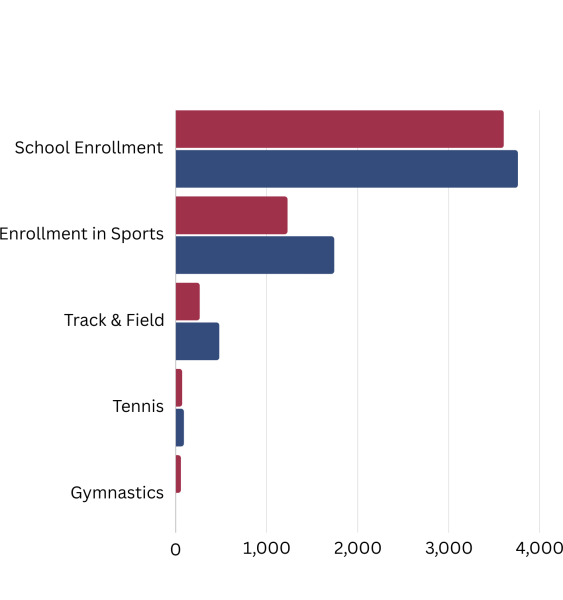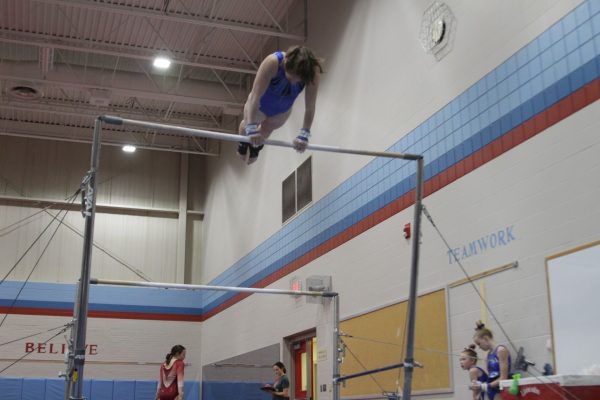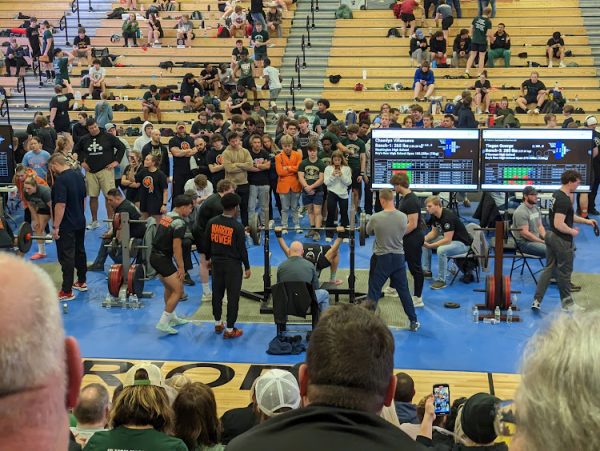The head coach of LHS track and field, James Jarovski, has coached for 26 years and has seen firsthand how the opportunity for everyone to participate in high school athletics benefits his students in every aspect of their lives.
“Probably about five years ago we had a student that struggled to get to class. He had a behavior problem…us as coaches, specifically myself and coach Rice, took him under our wing and encouraged him to be a part of track and field. We saw a gift in him and what he ended up doing was going to college [for track] and graduating from a Big 10 university. Without track and field that would not have been possible,” said Jarovski.
Track and field opened up an avenue for this student to develop the discipline necessary to successfully earn his college degree. This student, under potential changes in athletic requirements for the track and field program, would likely be prevented from being a part of the team. Similarly, there are students at LHS today who struggle with a lack of motivation and discipline that could be left out from athletic participation with the new enforcement of Title IX policy.
No-cut sports that don’t cap the maximum number of team roster spots, such as track and field, provide time for students that struggle in various ways to develop both in and out of the classroom. Track and field, powerlifting, tennis and other no-cut sports help to provide opportunities for students to excel beyond a solely academic standpoint. Athletic opportunities for LHS students are in jeopardy after the Sioux Falls School District’s decision to cut roster spots in certain boys’ sports.

There are many students throughout the School District who struggle with establishing social connections. Sports such as track and field provide an outlet for the challenges and stresses of school, and open opportunities for a sense of community, regardless of skill level.
“Some of our current seniors didn’t find a place where they could fit in, didn’t really have a friend group at Lincoln High School and decided to come out for track. They weren’t particularly talented, but they found what looks like lifelong friends right now, they hang out at basketball games…and all that was because of track and field,” said Jarovski.
The fact that those students, who were at first isolated, developed friendships through track and field emphasizes the importance of maintaining availability for all students to participate in athletics, not just those with natural athletic talent.
“We have some kids that are [physically disabled] who can’t compete for varsity athletics and other sports but they can go out there and compete with their classmates,” said Jarovski.
Competition is a highly important part of development both on and off the field. Physically disabled students are often left out of sports that limit the number of roster spots, which does not provide them with an equal opportunity to succeed. Maintaining equal opportunities ensures that everyone can find their place as a loved and respected part of the LHS community.
To provide context, in S.A. et al v. Sioux Falls School District, the lawsuit over cutting the high school gymnastics program in Sioux Falls, the court ordered a preliminary injunction. This was done in order to prevent the school district from selling the gymnastics equipment and cutting the program before the court’s official decision is made. Federal court cases sometimes take years and without the injunction all of the gymnastics equipment was scheduled to be sold and the sport would have been cut. Other than proving irreparable harm, there are three requirements for the court to grant a preliminary injunction with the most important being the likelihood for gymnastics to succeed based on the facts available. In this case, the court found in the preliminary injunction that “The District has not shown compliance with any of the three-prong tests of Title IX.” The three-prong tests of Title IX are three requirements, one of which needs to be met, in order for the school board to comply with Title IX. The first requirement calls for an equal percentage of participation in men’s and women’s sports. The second and third requirements involve providing opportunities and meeting the interests of the underrepresented sex. Since the school board removed gymnastics from the list of district sports that receive funding, the district can potentially no longer be considered in compliance with providing opportunities and meeting the interests of the underrepresented sex (prongs two and three). In response, they plan on reducing the percentage of participation in men’s sports to be in compliance with prong one. The difference in participation between the two sexes in the district is currently 7.6%, and while there is no set percentage to be in compliance with prong one of Title IX, it is clear that the number would have to significantly decrease.
Right now the school board is appealing the preliminary injunction to the 8th Circuit Court of Appeals. Based on the District Court’s interpretation of the law, in order for the school board to accomplish their goal of cutting gymnastics they would have to comply with prong one of Title IX. For this to happen the district either has to bolster participation in women’s sports or cut boys’ roster spots. Even though the coaches and administrators in the district are working hard to make the best of the situation and increase participation, in the time frame it is not realistic to achieve equal participation without the “adjustment” of roster spots in sports like track and tennis.

If the school district were to lose S.A. et al v. SFSD court case, they would be required to reinstate the gymnastics program and continue funding for the program. While this may seem costly, the price students will pay for the alternative is much greater. Currently, the district is trying several different strategies to win the lawsuit.
The district silenced coaches and administrators of the Sioux Falls School District in a recent email, and are only allowing the spread of minimal information. Information on the number of roster spots available in each sport is not allowed to be shared despite the high relevance to students. The parents and coaches of gymnastics have also been dealing with the lack of information.
“For a school district, this lack of transparency has been extremely frustrating and disappointing,” testified Angi Allen in S.A. et al v. SFSD. Allen has daughters with hopes to participate in gymnastics, who are directly affected by the School Board’s cutting of program funding.
The problem with the current proposed implementation of Title IX in response to the lawsuit is that instead of providing equal opportunity on the basis of sex, it may prevent equal opportunity for students who are underprivileged, isolated or incapacitated in ways that hinder them from participating in certain school sports.

As of right now, if one wants to protest against these measures there are multiple courses of action. One parent at LHS, Gregg Gohl, recently spoke at a school board meeting on the issue. He recommends that if any other parents are willing to get involved, they should contact the school board and voice their opinion. Gohl, along with individuals protecting the interests of the gymnastics program, are all frustrated with the school board’s lack of communication and agree that taking away opportunities from students is not the best course of action.











